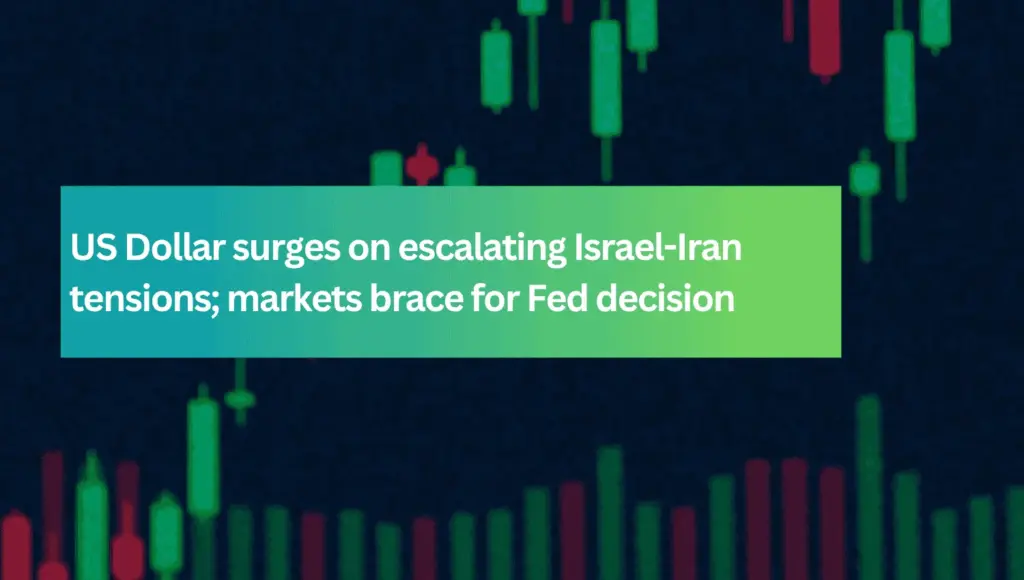Dollar rallies as geopolitical fears reignite safe-haven demand

The U.S. dollar index recorded its strongest daily rally in approximately a month on Tuesday, fueled by escalating geopolitical tensions between Israel and Iran, reigniting global investors’ appetite for safe-haven assets. The sharp increase in conflict intensity in the Middle East prompted broad risk aversion, causing traders to rotate back into the perceived safety of the U.S. dollar.
Adding to investor caution, crude oil prices surged sharply, climbing around 3%, overshadowing earlier optimism from an International Energy Agency (IEA) report that suggested ample global oil supply conditions throughout 2025. This spike in oil prices renewed concerns about potential inflationary pressures, complicating the monetary policy outlook and further enhancing the dollar's attractiveness as a protective investment in uncertain times.
US economic data disappoints, reinforcing cautious market sentiment
Investor mood was further dampened by weaker-than-expected U.S. economic indicators released on Tuesday. Retail sales data for May showed a steeper-than-anticipated decline, signaling underlying softness in consumer spending. Simultaneously, homebuilder sentiment dropped to its lowest level in two-and-a-half years, underscoring increasing vulnerabilities within the U.S. housing sector.
The subdued economic data pressured U.S. Treasury yields downward across the maturity spectrum, with yields falling between 4 and 7 basis points. The resulting flattening of the yield curve indicated growing market skepticism regarding the health of the U.S. economy and reinforced consensus expectations that the Federal Reserve is unlikely to deliver an immediate rate cut at the conclusion of its ongoing two-day policy meeting on Wednesday.
Middle East conflict escalates dramatically, driving risk-off positioning
The escalating conflict between Israel and Iran emerged as the dominant market theme, transcending conventional military actions to include an extensive digital warfare component. Reports indicated that Israel launched a significant cyberattack targeting Iranian digital infrastructure, significantly heightening market anxieties about broader regional instability.
U.S. President Donald Trump adopted an increasingly stern posture, explicitly calling for Iran’s “unconditional surrender” and demanding the immediate abandonment of its nuclear ambitions. Trump further demonstrated U.S. commitment by deploying additional fighter aircraft to the region, emphasizing American resolve and escalating global geopolitical tensions. Adding complexity to the situation, UAE Foreign Minister Sheikh Abdullah bin Zayed publicly warned of potential regional spillover effects, intensifying investors' concerns about wider economic and security implications.
Amid these developments, Russian President Vladimir Putin and Chinese President Xi Jinping are reportedly preparing for high-level discussions on the evolving Middle East situation, reflecting heightened international diplomatic concerns and further deepening market unease.
Euro and sterling pressured by geopolitical uncertainty and dollar strength
EUR/USD retreated sharply, breaking decisively below the key psychological threshold of 1.15 to hit its lowest level in nearly a week. Technical indicators pointed toward key support near 1.14, corresponding to recent price congestion and an ascending 21-day moving average. The euro's decline was accentuated by one-month risk reversal data indicating significantly reduced bullish sentiment among traders, suggesting increasing vulnerability for the single currency amid heightened global uncertainty.
GBP/USD faced even greater selling pressure, dropping dramatically by approximately 1%, as investor sentiment turned cautious despite supportive developments in U.S.-UK trade relations. Notably, President Trump formalized a reduction in tariffs on British imports, part of ongoing bilateral trade negotiations. Nevertheless, the pound approached critical technical support near June lows around 1.3417 and its lower Bollinger band at approximately 1.3390, reflecting the dominant impact of geopolitical tensions and broad dollar strength.
Yen weakens despite safe-haven backdrop; technical factors in focus
Contrary to its typical safe-haven behavior, the Japanese yen weakened against the dollar on Tuesday, with USD/JPY advancing firmly into its technical Ichimoku cloud range between 144.89 and 145.59. The pair’s upward movement was primarily driven by the dollar’s broad-based strength, higher oil prices, and shifting expectations surrounding Wednesday’s pivotal Federal Reserve policy announcement.
From a technical perspective, USD/JPY’s clear break into this cloud zone signaled potential for further bullish momentum, contingent upon Fed communications. Large-scale option expiries around the psychologically important 145 level further complicated market positioning, influencing traders' cautious approach.
Equities decline amid growing investor caution; commodities reflect mixed sentiment
U.S. equity markets mirrored the overall cautious tone, with the S&P 500 index declining by 0.78%, weighed down notably by losses in healthcare and consumer discretionary sectors. This weakness reflected growing investor uncertainty about both domestic economic prospects and the evolving geopolitical landscape.
Commodity markets presented a mixed picture. Gold prices were broadly stable, balancing heightened geopolitical-driven demand against dollar strength. Meanwhile, copper prices declined by approximately 0.86%, reflecting investor caution regarding the broader outlook for global economic growth amid escalating uncertainties.
Market outlook cautious as traders await key Fed decision
Overall, Tuesday’s market movements underscored a pronounced shift toward risk aversion, driven primarily by dramatic geopolitical developments in the Middle East and compounded by weaker-than-anticipated U.S. economic data. As markets move toward Wednesday’s crucial Federal Reserve decision, investors will closely scrutinize Fed Chair Lael Brainard’s statements and updated economic projections to gauge potential shifts in monetary policy stance. These developments, combined with ongoing geopolitical tensions, are likely to maintain heightened volatility and cautious positioning across global financial markets in the days ahead.
